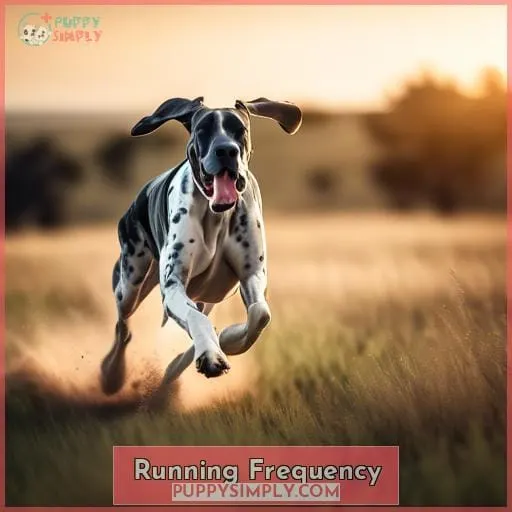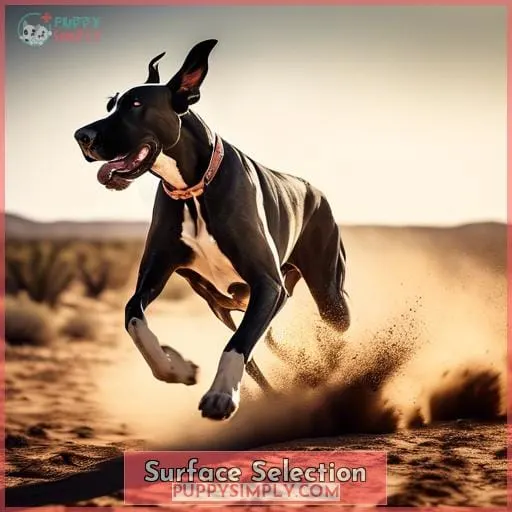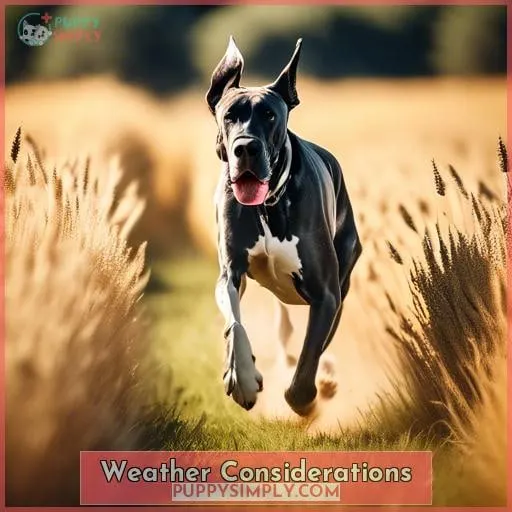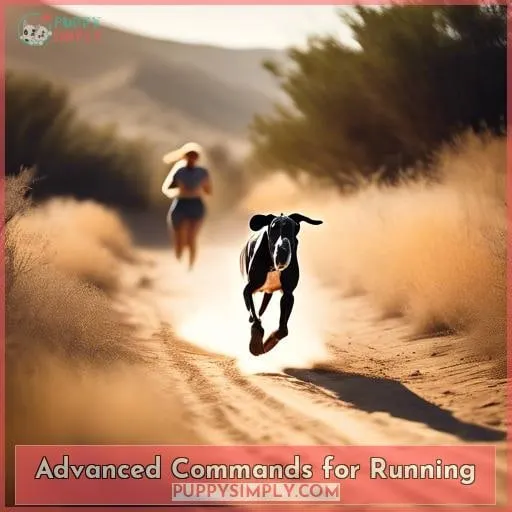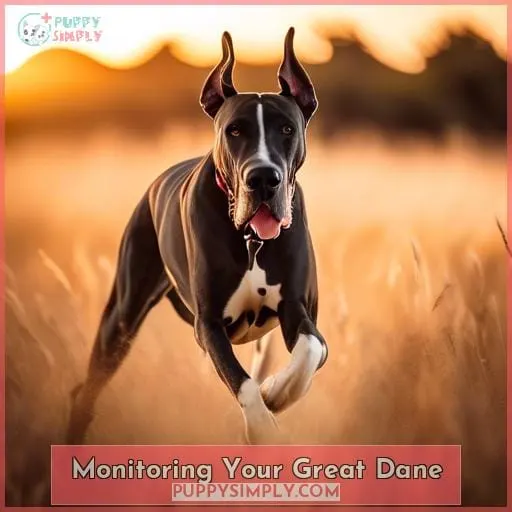This site is supported by our readers. We may earn a commission, at no cost to you, if you purchase through links.

However, it’s crucial to approach this activity with knowledge and care due to the breed’s unique characteristics and needs.
Great Danes are known for their gentle nature and imposing size, but they also come with specific health concerns, such as joint and bone diseases, including hip dysplasia and osteoarthritis.
These conditions necessitate a careful balance between providing enough exercise to maintain health and avoiding excessive strain on their joints.
Great Danes are capable of short bursts of speed, reaching up to 30 miles per hour, but they lack the stamina for long-distance running.
Their exercise needs can be met with daily walks and the opportunity to play in a secure environment.
When introducing running, it’s important to start with a run-walk cadence and gradually increase distance, always paying attention to your dog’s stamina and signs of fatigue.
Running should be limited to surfaces that minimize orthopedic wear and tear, and frequency should be carefully managed, starting with one run per week and slowly increasing as desired.
In summary, while Great Danes can enjoy running as part of their exercise routine, it’s essential to adapt this activity to their physical capabilities and health requirements.
By doing so, you can ensure a safe and enjoyable running experience for both you and your Great Dane.
Table Of Contents
- Key Takeaways
- Understanding Great Danes
- Age Considerations
- Starting to Run
- Running Distance
- Running Frequency
- Surface Selection
- Weather Considerations
- Heel and Leash Training
- Advanced Commands for Running
- Monitoring Your Great Dane
- Frequently Asked Questions (FAQs)
- What type of harness or collar should I use when running with my Great Dane?
- How can I keep my Great Dane hydrated on longer runs?
- Is it okay for my Great Dane to run on sand or soft trails?
- Should I feed my Great Dane before or after our run?
- Are there any signs of injury I should watch for when running with my Great Dane?
- Conclusion
Key Takeaways
- Great Danes can run, but due to their size and potential for joint issues, they should not be pushed to run long distances. The maximum recommended distance for a run with a Great Dane is around 3 miles, and even this should be built up to gradually, starting with a run-walk cadence.
- Regular exercise is important for Great Danes, but it should be balanced with their health needs. Over-exercising, especially in puppies, can lead to health issues such as joint damage. Exercise routines should be adapted to the dog’s stamina and health condition.
- Great Danes are prone to certain health issues, including joint and bone diseases like hip dysplasia and osteoarthritis, and bloat or gastric dilatation-volvulus (GDV). Regular vet consultations, proper nutrition, and injury prevention practices are crucial for their health management.
- Safety considerations are important when running with Great Danes. Softer terrains like dirt trails or grass are recommended for running. It’s also important to monitor the dog’s comfort and health closely during and after runs, and to allow for proper recovery time.
Understanding Great Danes
As you consider incorporating running into your Great Dane’s routine, it’s essential to understand their breed characteristics, exercise needs, and common health concerns.
Your gentle giant requires careful exercise management to maintain their health and happiness.
Breed Characteristics
Understanding the unique characteristics of Great Danes is crucial when integrating running into their routine.
As one of the largest breeds, Great Danes are known for their gentle, playful, and loyal nature.
They require a balanced diet rich in nutrients, particularly for their size.
Regular grooming and socialization are also important for their overall well-being.
However, due to their size, they’re prone to joint damage and other health issues, especially when running long distances.
Exercise Needs
How do Great Danes’ exercise needs evolve as they grow, and what’s the best way to keep them healthy and engaged?
You’ll find that while Great Danes are indeed powerful and energetic, their exercise requirements must be carefully managed to avoid health issues.
As puppies, they should have short, gentle walks and plenty of opportunities for free play to avoid stress on their developing joints.
As they mature, their exercise can become more structured and can include longer walks, hikes, and eventually, running, but always with a mindful approach to their large size and potential for joint problems.
Common Health Concerns
While you’re ensuring your Great Dane gets the right amount of exercise, it’s equally important to be aware of the common health concerns that can affect this breed, given their large size and specific genetic predispositions.
Great Danes are susceptible to joint and bone diseases like hip dysplasia and osteoarthritis, which can be exacerbated by improper exercise or obesity. Bloat, or gastric dilatation-volvulus (GDV), is a life-threatening condition that requires immediate veterinary attention.
To prevent such issues, adhere to vet consultation schedules, maintain weight management through proper nutrition tips, and engage in injury prevention practices. Regular preventive care, including health screenings for genetic conditions, is crucial for the longevity and well-being of your Great Dane.
When training dogs to run, consider the distance dogs can run and adjust according to your Great Dane’s health status and stamina.
Age Considerations
When it comes to running with your Great Dane, age is a crucial factor to consider.
As they grow rapidly as puppies, it’s recommended to avoid leash running until they’re 18 months old to prevent joint damage and orthopedic issues.
However, off-leash play in open areas is beneficial for muscle development.
Leash walking is a safe, low-impact exercise option.
Puppy Exercise Guidelines
In your journey of raising a Great Dane puppy, it’s crucial to remember that their exercise needs are unique due to their rapid growth and large size.
Prioritize Puppy Socialization over distance running; short, supervised playtimes encourage healthy interactions.
Protect Joint Health by avoiding high-impact activities until growth plate development is complete.
Begin Leash Training early, focusing on gentle walks rather than running.
Maintain a Playtime Balance, ensuring soft surfaces for exercise to support their growing bodies.
Adult Exercise Needs
After transitioning from puppy exercise guidelines, it’s crucial to understand that as your Great Dane matures, their exercise needs evolve too.
Nutrition essentials play a key role in joint health and weight management. Mental stimulation and playtime activities are equally important.
Our Great Danes running guide emphasizes the importance of:
- Knowing your dog
- Choosing the right gear for running with dogs
- The benefits of running with dogs off-leash
Starting to Run
When you’re ready to start running with your Great Dane, it’s crucial to begin with a run-walk cadence.
This approach allows your dog to gradually adapt to the new activity, ensuring both mental and physical readiness for running on a leash.
As you both gain confidence and build endurance, you can slowly increase the distance of the running segments, always mindful of your Great Dane’s comfort and health.
Run-Walk Cadence
Once your Great Dane has reached the appropriate age and is comfortable with leash walking, you can start introducing a run-walk cadence. This interval training method is crucial for pacing strategies that foster canine fitness without risking injury.
Proper leash management ensures safety during these sessions. As your Dane’s endurance builds, you’ll find trail running with your dog becomes a joy.
Gradual Distance Increase
Starting to run with your Great Dane, you’ll want to gradually increase the distance, beginning with a run-walk cadence to help your dog adapt.
This approach ensures a smooth transition into running, prioritizing your dog’s health and well-being.
Here’s how to embark on this journey:
- Start Small:
- Begin with short distances, focusing on a mix of running and walking.
- This helps in conditioning your dog’s muscles and joints, preparing them for longer distances.
- Monitor Progress:
- Keep a close eye on how your dog responds after each run.
- Look for signs of fatigue or discomfort, which could indicate that you’re advancing too quickly.
- Incremental Increases:
- Gradually extend the distance of the running segments by about 10% each week.
- This steady progression aids in building endurance without overwhelming your dog.
- Listen to Your Dog:
- Pay attention to your Great Dane’s cues.
- If they seem energetic and eager, it might be okay to slightly increase the distance.
- However, if they appear tired or reluctant, it’s a sign to slow down.
By following these steps, you’re not just focusing on physical conditioning but also nurturing a deeper bond with your Great Dane.
This journey of gradual distance increase is as much about enjoying the shared experience as it’s about achieving fitness goals together.
Running Distance
When considering running distances with your Great Dane, it’s crucial to prioritize their health and enjoyment while ensuring safety.
Start with short distances, using a run-walk cadence to gently introduce your Dane to running alongside you. This approach helps them adapt both mentally and physically, preventing undue stress on their developing joints.
Maximum Recommended Distance
As you transition from learning the basics of running with your Great Dane to focusing on how far you can safely take them, it’s crucial to understand that 3 miles is the maximum recommended distance for these gentle giants on a leash.
Prioritize injury prevention by managing pace and including rest intervals.
Heel and leash training will enhance joint health and overall control.
Use fitness tracking to monitor progress and adapt frequency.
Biked walks can also complement your routine, ensuring your Great Dane’s well-being.
Adapting to Your Dog’s Stamina
While the maximum recommended distance for running with your Great Dane is three miles, you’ll need to pay close attention to your dog’s stamina and adjust accordingly.
Building Endurance:
- Start slow, mirroring strategies used for breeds known for their stamina like Labrador Retrievers and Dalmatians.
Pacing Strategies:
- Incorporate walking intervals, similar to training approaches for German Shorthaired Pointers and Vizslas, to manage energy levels.
Hydration Tips:
- Always ensure water is accessible, crucial for maintaining hydration like the needs of active breeds such as Greyhounds.
- Recognize signs of fatigue early, and be ready to adjust the training intensity to keep your Great Dane healthy and happy.
Running Frequency
When starting to run with your Great Dane, it’s crucial to begin with one run per week.
This gradual approach helps prevent overexertion and ensures your Dane’s health and safety.
Slowly increasing the frequency of runs allows your dog to adapt comfortably and enjoyably to the new activity.
Starting With One Run Per Week
Your Great Dane’s initial foray into running should be limited to once a week.
This ensures their body has ample time to rest and adapt to the new activity.
This gradual progression helps avoid overexertion, while also providing enjoyable experiences and bonding opportunities.
| Belgian Malinois | German Shepherds | Great Danes |
|---|---|---|
| High energy, frequent runs | Moderate energy, regular runs | Low energy, weekly runs |
Just like with Jack Russell Terriers, Pit Bulls, or Weimaraners, monitoring health is crucial.
Increasing Frequency Safely
You’ll want to start with just one run a week, then gradually add more days as you both get more comfortable with the routine.
Incorporate rest intervals between runs to allow for recovery.
Monitor for signs of fatigue, adjusting frequency and distance as needed.
Vary the terrains you run on, much like Australian Shepherds enjoy, to provide mental stimulation and different physical challenges.
Surface Selection
When selecting the best surface for running with your Great Dane, it’s crucial to prioritize their joint health and overall comfort.
Opting for softer terrains like dirt trails or grass can significantly reduce the impact on their joints compared to harder surfaces such as concrete.
These natural surfaces not only offer a safer running experience but also provide a more enjoyable and pollution-free environment for both you and your Great Dane.
Hard Vs. Soft Surfaces
Considering the impact on your Great Dane’s joints, opting for surfaces like dirt trails or grass is when running together.
Soft terrain plays a crucial role in joint health by significantly reducing the impact of each stride.
This choice not only emphasizes surface safety but also nurtures a sense of freedom and belonging to the natural world.
When weighing grass vs concrete, the former emerges as the clear winner for your gentle giant’s well-being and your shared enjoyment.
Ideal Running Locations
For selecting the ideal running locations for your Great Dane, consider:
- Softer surfaces like dirt trails and grassy areas to minimize joint impact and reduce the risk of injury.
- Park trails offer a scenic and joint-friendly route.
- Beach runs provide a unique terrain that can enhance muscle development.
- Forest paths invite exploration and exercise amidst nature.
- Countryside routes deliver fresh air and open spaces for a stress-free run.
- Urban parks, with their mix of grass and paths, are convenient for city-dwelling Great Danes and their owners.
Weather Considerations
When it comes to running with your Great Dane, weather conditions play a crucial role.
Both hot and cold weather can pose challenges for this breed.
In hot weather, Great Danes can quickly become dehydrated and are at risk of heatstroke.
In cold weather, their short coats and lean builds make them sensitive to frigid temperatures.
Therefore, it’s essential to monitor your dog’s comfort and health closely, adjusting your running routine as necessary to ensure their safety.
Running in Hot Weather
While it’s tempting to take your Great Dane out for a run on a sunny day, you should be mindful of the potential risks associated with hot weather.
Hydration Tips:
- Always carry water for both you and your dog to prevent dehydration.
Cooling Techniques:
- Utilize shaded paths.
- Invest in a cooling vest for your Dane.
Heat Stroke:
- Learn the signs, such as excessive panting and drooling, to act quickly.
Early Morning Runs:
- Opt for cooler temperatures and softer light.
Paw Protection:
- Hot surfaces can burn paws; consider protective booties.
Running in Cold Weather
As you prepare to run with your Great Dane in cold weather, it’s crucial to recognize their sensitivity to low temperatures due to their short coats and lean builds.
Layering essentials like a fitted dog jacket can provide warmth without restricting movement.
Hydration remains key, even in the cold, so offer water before and after your outings.
Protect their paws with booties to prevent frostbite.
Use a gradual warm-up to ease into the run, safeguarding muscles and joints.
Heel and Leash Training
Before you can enjoy running with your Great Dane, it’s crucial to establish proper leash manners.
This begins with heel and leash training, which ensures your dog understands how to walk calmly by your side.
By reinforcing these skills, you’ll create a safer and more enjoyable experience for both of you when transitioning to running.
Importance of Leash Manners
Transitioning from weather considerations to leash manners, your Great Dane’s comfort during runs isn’t just about the temperature; it’s also about how they’re guided.
You’ve got to ensure they’re well-versed in leash etiquette before hitting the pavement together.
Reinforcing commands consistently will help manage distractions, keeping your companion focused and safe.
Proper leash manners are the foundation of a harmonious run, ensuring both freedom and security for your shared outings.
Transitioning to Running
Mastering the transition from walking to running with your Great Dane requires building on the foundation of good leash manners you’ve already established.
You’ll need to ensure your dog is comfortable maintaining the heel position while gradually introducing the dynamics of running, making the experience enjoyable and safe for both of you.
Begin with proper warm-up exercises to prevent injuries, and use the right equipment to support your Dane’s size and strength.
Transitioning techniques and canine conditioning are key to a smooth shift, ensuring a healthy, happy running partner.
Advanced Commands for Running
To ensure your Great Dane’s safety and enjoyment while running, it’s crucial to teach them advanced commands that go beyond basic obedience.
These commands will help you navigate turns and manage your dog’s movements without the need for manual leash guidance, which can be cumbersome during a run.
As you progress in your running routine, incorporating commands for directional changes and teaching your Great Dane to respond to them reliably will make your joint exercise more pleasurable and safe.
Essential Commands for Safety
Once you’ve got your Great Dane walking nicely on a leash, it’s time to introduce some essential commands for safety during your runs together.
Begin with recall training, ensuring your companion can return to you amidst distractions.
Teach emergency stops to prevent mishaps, and boundary awareness to maintain a safe path.
Directional cues help navigate turns and obstacles, while pace adjustment commands keep your run smooth.
These skills are crucial for a secure and enjoyable running experience.
Off-Leash Running Considerations
A few essential commands allow your Great Dane the freedom to safely run off-leash.
Off-leash running provides important opportunities for playful interaction, muscle development, and socialization benefits, but always requires your supervision.
Mastering solid recall and freeze commands enables your Dane to enjoy safe, controlled off-leash running.
Start in enclosed areas without major distractions and reward compliance generously.
Only progress to more challenging areas after achieving consistent off-leash control.
Freedom must be earned through proofing commands, but the rewards are immense for both you and your happy, well-socialized companion.
Monitoring Your Great Dane
As your Great Dane runs, watch for signs of fatigue.
Allow for proper rest and recovery after exercise to prevent injury.
Monitoring your dog’s condition during and after runs is key for their health.
Signs of Fatigue
During your runs, watch for signs of fatigue in your Great Dane.
Stumbling, slowing down, panting excessively, or failure to respond to commands indicate a need for rest.
Stop for water and a short break if you notice these signs.
Observe your dog’s body language closely before resuming your pace – ears back, head down, and reluctance to continue running all signal more rest is needed.
If fatigue persists or you have concerns, consult your veterinarian about adjusting your running routine.
With attentive monitoring, you can maximize enjoyment and distance for you both!
Post-Run Recovery
After signs of fatigue, you’ll need to properly monitor your Great Dane during post-run recovery:
- Provide fresh water for rehydration.
- Massage muscles to prevent soreness.
- Use cooling vests or fans to lower body temperature.
- Feed a protein-rich meal for replenishment.
- Support joint health with supplements like glucosamine.
Frequently Asked Questions (FAQs)
What type of harness or collar should I use when running with my Great Dane?
Use a front-clip no-pull harness to stop pulling and minimize strain on your Great Dane’s neck during runs.
The harness evenly distributes pressure across the chest, not the throat, for comfort and control.
Gradually build distance as your Dane trains.
How can I keep my Great Dane hydrated on longer runs?
Carrying a pet water bottle, you’ll ensure your Great Dane stays hydrated during runs.
They need about 1 ounce of water per pound daily.
Is it okay for my Great Dane to run on sand or soft trails?
Running on sand or soft trails is ideal for your Great Dane.
These surfaces help ease joint pressure and reduce the risk of injury.
Just watch out for hot sand to protect their paws.
Should I feed my Great Dane before or after our run?
Feed your Great Dane at least one hour before or two hours after running.
This will help prevent bloat, a serious health risk for deep-chested breeds.
Are there any signs of injury I should watch for when running with my Great Dane?
As you run with your Great Dane, watch for signs of discomfort:
- Lameness
- Stiffness
- Difficulty getting up
- A bunny hop run
Changes in behavior can also indicate pain:
- Reluctance to exercise
- Decreased activity
If your Dane shows signs of pain, consult your vet immediately:
- Whimpering or flinching when touched
- Lumps
- Swelling
- Weight loss
Conclusion
Like a thoroughbred racing to the finish line, your Great Dane can be an exhilarating running partner.
Yet pace yourself – though eager to bound alongside you for miles, their joints may tire before their spirit.
Let your dog’s signals guide your route’s length; a shortened amble home remains a shared joy.
With mindfulness, you and your sighthound can run long and strong.





